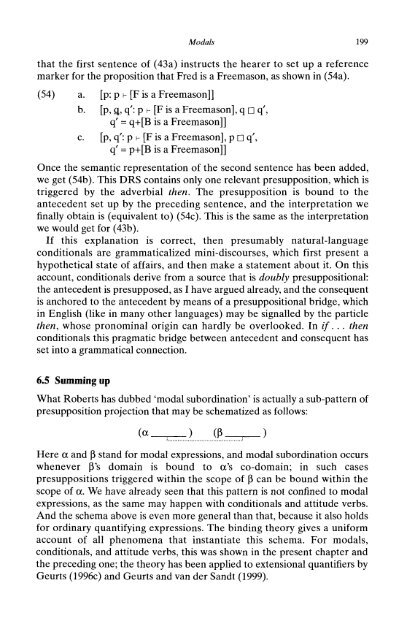Presuppositions and Pronouns - Nijmegen Centre for Semantics
Presuppositions and Pronouns - Nijmegen Centre for Semantics
Presuppositions and Pronouns - Nijmegen Centre for Semantics
Create successful ePaper yourself
Turn your PDF publications into a flip-book with our unique Google optimized e-Paper software.
Modals 199<br />
that the first sentence of (43a) instructs the hearer to set up a reference<br />
marker <strong>for</strong> the proposition that Fred is a Freemason, as shown in (54a).<br />
(54) a. [p: p f- H [F is a Freemason]]<br />
b. [p,.q, q': p f- i- [F is a Freemason], q 0 n q',<br />
q' = q+[B is a Freemason]]<br />
c. [p, q': p f- h [F is a Freemason], pDq', p n q' = p+[B is a Freemason]]<br />
Once the semantic representation of the second sentence has been added,<br />
we get (54b). This DRS contains only one relevant presupposition, which is<br />
triggered by the adverbial then. The presupposition is bound to the<br />
antecedent set up by the preceding sentence, <strong>and</strong> the interpretation we<br />
finally obtain is (equivalent to) (54c). This is the same as the interpretation<br />
we would get <strong>for</strong> (43b).<br />
If this explanation is correct, then presumably natural-language<br />
conditionals are grammaticalized mini-discourses, which first present a<br />
hypothetical state of affairs, <strong>and</strong> then make a statement about it. On this<br />
account, conditionals derive from a source that is doubly presuppositional:<br />
the antecedent is presupposed, as I have argued already, <strong>and</strong> the consequent<br />
is anchored to the antecedent by means of a presuppositional bridge, which<br />
in English (like in many other languages) may be signalled by the particle<br />
then, whose pronominal origin can hardly be overlooked. In if. .... . then<br />
conditionals this pragmatic bridge between antecedent <strong>and</strong> consequent has<br />
set into a grammatical connection.<br />
6.5 Summing up<br />
What Roberts has dubbed 'modal subordination' is actually a sub-pattern of<br />
presupposition projection that may be schematized as follows:<br />
(a (« ;____________}) ____________(P.—, ~P. J )<br />
Here u a <strong>and</strong> ~ (3 st<strong>and</strong> <strong>for</strong> modal expressions, <strong>and</strong> modal subordination occurs<br />
whenever Ws (3's domain is bound to a's co-domain; in such cases<br />
presuppositions triggered within the scope of ~ (3 can be be bound within the<br />
scope of a. u. We have already seen that this pattern is not confined to modal<br />
expressions, as the same may happen with conditionals <strong>and</strong> attitude verbs.<br />
And the schema above is even more general than that, because it also holds<br />
<strong>for</strong> ordinary quantifying expressions. The binding theory gives a uni<strong>for</strong>m<br />
account of all phenomena that instantiate this schema. For modals,<br />
conditionals, <strong>and</strong> attitude verbs, this was shown in the present chapter <strong>and</strong><br />
the preceding one; the theory has been applied to extensional quantifiers by<br />
Geurts (1996c) <strong>and</strong> Geurts <strong>and</strong> van der S<strong>and</strong>t (1999).














